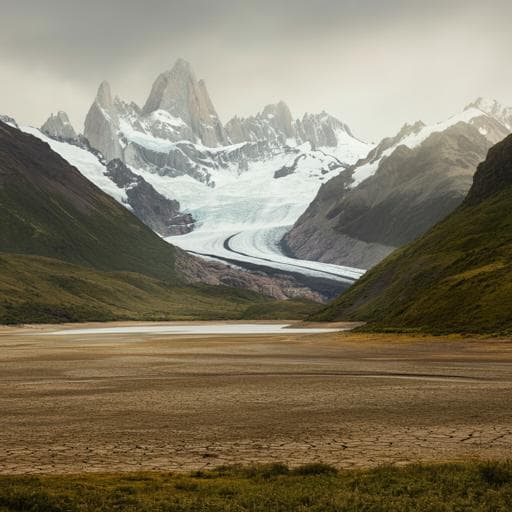
Earth Sciences
Andean drought and glacial retreat tied to Greenland warming during the last glacial period
A. Woods, D. T. Rodbell, et al.
Discover how abrupt warming events in Greenland influence Andean precipitation and glacier dynamics! This research sheds light on the significant hydroclimatic disruptions experienced in the Amazon Basin during Arctic warming, led by Arielle Woods and colleagues.
~3 min • Beginner • English
Introduction
Variations in Atlantic Meridional Overturning Circulation (AMOC) during the last glacial cycle altered the interhemispheric thermal gradient, shifting the mean Intertropical Convergence Zone (ITCZ) and trade wind strength. Low-latitude South American paleoclimate is sensitive to such high-latitude forcing via the South American summer monsoon (SASM), which strengthened during cold stadials (e.g., Heinrich events) and weakened during abrupt Greenland warmings (Dansgaard-Oeschger, DO, interstadials). While large fluctuations in Andean paleolake levels and glacier advances have been linked to stadials, the impacts of shorter DO cycles on precipitation and Andean glacier mass balance are less clear. Many prior inferences rely on speleothem δ18O, which integrates upstream processes and may not isolate local precipitation. This study presents a well-dated, continuous, δ18O-independent sediment record from Lake Junín, Peru, to test how DO interstadials affected local hydroclimate and glacier mass balance in the tropical Andes over the past ~50 ka.
Literature Review
Previous work documents large Andean paleolake level rises on the Bolivian Altiplano tied to the Younger Dryas and Heinrich events 1–2, with associated glacier advances or stillstands in some cases. However, the effects of shorter DO interstadials on precipitation anomalies and tropical Andean glaciers remain uncertain. Speleothem δ18O records across Amazonia and adjacent regions capture regional SASM variability driven by upstream convection and rainout, but at several sites δ18O of precipitation does not tightly couple with independent local precipitation proxies, indicating influences beyond the amount effect. Moraine exposure age chronologies record glacier extent but have limitations (±~5% age uncertainty, unknown lag between advance and stabilization, and overprinting by larger advances). There is a need for well-dated, continuous, δ18O-independent hydroclimate records to resolve local precipitation and glacier mass-balance responses to abrupt climate events.
Methodology
Study site: Lake Junín (11°S; ~4100 masl) in the central Peruvian Andes is a seasonally closed-basin lake (~280 km²; ~8–12 m deep) situated between the eastern and western cordilleras. The catchment includes groundwater-fed peatlands (bofedales) and is bordered by glacial outwash fans and moraines. The region receives most precipitation during austral summer (DJF) via the SASM, with <7% in winter (JJA). Glaciers at this latitude (outer tropics) are highly sensitive to precipitation changes. During the local last glacial maximum (LLGM; ~28.5–22.5 ka), glaciers descended from ~4700 masl to ~4160 masl; final deglaciation of the Junín watershed was nearly complete by ~18 ka. Core collection and analyses: Sediment cores were retrieved from the lake depocenter (water depth 8.2 m). Sedimentary proxies include high-resolution XRF core scanning (e.g., Ti and Si counts per second) to track clastic inputs, siliciclastic sediment flux, total organic carbon (TOC), and dry bulk density. Peat layers (1–20 cm thick; 5–35% TOC) with abundant macrofossils indicate lake low stands and were used to infer water-level fluctuations (up to ~8 m). Chronology: The age model for the last 50 ka (cal yr BP) is based on 79 AMS radiocarbon dates on terrestrial macrofossils and charcoal, modeled with the Bacon Bayesian age-depth approach. Glacial geomorphic context was informed by 10Be exposure ages on moraines (recalculated using updated production rates/scaling). Post-~20 ka decline in clastic input is interpreted as a shift to glacier retreat behind moraine-dammed lakes that trapped sediment, with increased authigenic CaCO3 deposition and laminations in late glacial sediments. The proxies collectively provide a continuous, local record of relative precipitation (via lake level/peat occurrence) and glacier mass balance (via glacigenic clastic input).
Key Findings
- The Lake Junín sediment record spans the last ~50 ka with an age model constrained by 79 radiocarbon dates on terrestrial macrofossils.
- DO interstadials (notably 4–13) coincide with sharp reductions in glacigenic clastic input (lower Ti, Si, siliciclastic flux), widespread peat accumulation, and lowered lake levels by up to ~8 m, indicating major droughts and weakened SASM.
- Many DO events were sufficient to cause near-complete disappearance of glaciers below ~4700 masl in the adjacent eastern Andean cordillera.
- Peat layers (1–20 cm thick, 5–35% TOC) represent repeated low stands lasting ~25–500 years based on sedimentation rates, demonstrating centennial-scale hydroclimatic variability.
- Deglaciation of the Junín watershed was nearly complete by ~18 ka, marked by a near-total cessation of clastic input, reflecting glacier retreat behind sediment-trapping proglacial lakes rather than a precipitation decrease.
- Lake level at Junín is especially sensitive to precipitation amount; no lake-level lowering is observed during the 20–15 ka regional warming, indicating temperature had less direct effect on lake level than precipitation.
- Two prolonged droughts (~22.5–21.9 ka and ~20.8–20.1 ka; total ~1300 years) occurred prior to global deglaciation, likely driving early glacier retreat in the central Peruvian Andes.
- The magnitude and duration of Junín’s hydroclimatic response to DO events can be disproportionate to nearby speleothem δ18O signals (e.g., Pacupahuain), highlighting that δ18O integrates multiple processes and may not linearly reflect local precipitation amount.
- Regional coherence: Junín dryness during DO events aligns with speleothem δ18O indications of weaker SASM and with Amazon River discharge variability; Junín preferentially records dry (DO) events, whereas Altiplano lake records are more sensitive to wet (Heinrich) events.
Discussion
The Junín record provides a direct, local, δ18O-independent reconstruction showing that abrupt Greenland warmings (DO interstadials) were associated with weakened SASM, drought, lowered lake levels, and glacier retreat in the tropical Andes. This links high-latitude North Atlantic variability (AMOC-driven thermal gradients affecting ITCZ position) to hydroclimatic and cryospheric changes in the highest reaches of the Amazon Basin. The tight correspondence between Junín proxies and regional speleothem δ18O indicates that monsoon strength was a first-order control, yet differences in event magnitude and duration demonstrate that speleothem δ18O reflects upstream processes beyond local rainfall amount. The early onset of Andean deglaciation (~22.5 ka) is better explained by prolonged droughts rather than early regional warming, consistent with a period of relatively strong AMOC and drier Amazon conditions without large southward ITCZ displacements. Collectively, the findings underscore precipitation’s dominant role in outer-tropical Andean glacier mass balance and water availability, and they provide a paleoclimate analog for potential future responses to Arctic amplification and AMOC changes.
Conclusion
This study presents a well-dated, continuous sediment record from Lake Junín demonstrating that DO interstadials during the last ~50 ka produced major droughts, lowered lake levels by up to ~8 m, and widespread glacier retreat (to above ~4700 masl) in the central Peruvian Andes via SASM weakening. The record clarifies the precipitation-driven sensitivity of outer-tropical Andean glaciers and reveals that δ18O speleothem signals, while regionally coherent, may not scale with local hydroclimate impacts. The identification of prolonged droughts preceding global deglaciation provides a mechanism for early Andean deglaciation. Future research could quantify absolute precipitation changes, expand comparable lake-based records across the tropical Andes to map spatial hydroclimate heterogeneity, integrate isotope-enabled climate modeling to reconcile δ18O and local precipitation signals, and assess implications for future water resources under projected Arctic warming and potential AMOC variability.
Limitations
- Age control is less robust during intervals lacking datable macrofossils (e.g., parts of the LLGM), increasing uncertainty around DO 2–3 timing.
- XRF-derived clastic inputs and related proxies reflect relative, not absolute, precipitation changes and can be influenced by sediment routing and trapping (e.g., proglacial lakes post-~20 ka).
- Speleothem δ18O comparisons indicate potential decoupling from local precipitation amount due to upstream and transport-related isotopic effects, complicating direct quantitative inferences of rainfall from δ18O.
- Lake-level inferences from peat layers assume consistent depositional and geomorphic context; while no unconformities are detected within age-model precision, some fine-scale hydrologic complexity may not be resolvable.
Related Publications
Explore these studies to deepen your understanding of the subject.







